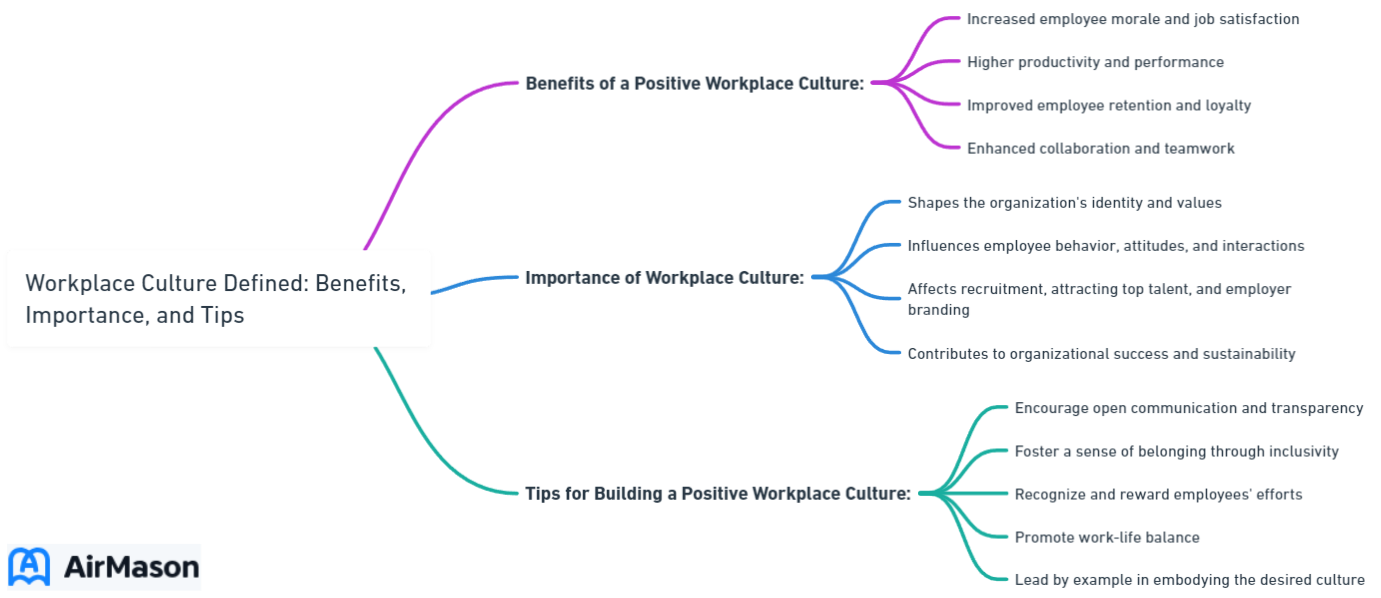
In today’s fast-paced and ever-evolving business landscape, workplace culture has emerged as a critical factor that can make or break an organization’s success. A positive and inclusive “workplace culture defined” not only fosters employee happiness but also drives business performance and growth. Are you ready to unlock the full potential of your organization by cultivating a healthy workplace culture? Let’s dive in!
Key Takeaways
- Create an engaging and positive workplace culture to attract top talent, foster collaboration & innovation, and drive success.
- Leaders must prioritize diversity & inclusion, open communication, training & recognition for employees to succeed.
- Companies like Twitter have demonstrated the value of a strong workplace culture in improving employee satisfaction and engagement.
Defining Workplace Culture
Workplace culture is essentially the heartbeat of an organization. It represents the dynamic set of shared values, beliefs, attitudes, and behaviors that create an engaging and positive experience for employees within an organization. A strong company’s culture is built upon a well-defined set of values that serve as the cornerstone for decision-making and daily actions. Every aspect of a company culture, from the CEO’s response to a crisis to how a team adjusts to new customer demands, plays a crucial role in shaping the behavior of employees and the organization as a whole.
A healthy culture fuels a positive company culture and productive work environment, aiding organizations in:
- Staying competitive
- Attracting top talent
- Innovating new products or services
- Fostering a collaborative, harmonious workplace
By clearly defining your company’s values and ensuring they align with the actions taken within the business, you are laying the foundation for a thriving culture that promotes employee happiness and overall success. Make sure to maintain this alignment for continued growth.

Core Components
Workplace culture revolves around:
- Organizational values
- Identity
- Norms
- Policies
- Communication
- The working environment
A robust set of values serves as a guiding compass for every decision and action, making it a fundamental ingredient for a successful workplace culture. Workplace norms, on the other hand, are the essential rules and traditions that help employees navigate their work environment and achieve their best possible performance.
Thriving workplace cultures rely heavily on effective communication, which helps build strong relationships rooted in mutual respect and trust. Open, two-way conversations are essential for fostering engagement and creating a positive workplace culture that values diverse perspectives and encourages continuous learning.
Organizations can take a proactive approach to ensure that their values are reflected in their actions by examining how they treat employees and customers, how active they are in the community, and how diverse their leadership team is.
The Role of Leadership
Leaders play a pivotal role in shaping and maintaining a positive workplace culture. Their actions, communication, and support for employees can make a lasting impact on the overall culture and success of an organization. When leaders live up to the values they promote, they inspire trust and commitment from their team members, which in turn boosts morale and productivity.
Leaders can prioritize workplace culture by:
- Actively engaging in conversations about the organization’s culture and values
- Taking employee feedback into account
- Advocating for culture-building initiatives
By establishing and reinforcing helpful organizational culture and workplace norms, leaders can create an environment that fosters trust, collaboration, and innovation, ultimately leading to increased employee satisfaction and organizational success.
An Organization’s Culture
An organization’s culture encompasses the shared values, beliefs, and practices that shape the way individuals interact and work together within a company. It is the intangible but powerful force that influences employee behavior, decision-making, and overall performance. This culture often stems from the company’s mission and vision, reflecting its identity and purpose. A healthy organizational culture fosters a sense of belonging and encourages employees to align their efforts with the company’s objectives. Conversely, a toxic culture can lead to disengagement, high turnover rates, and hindered productivity. Therefore, cultivating a positive and inclusive organizational culture is not only essential for employee satisfaction but also for the long-term success and sustainability of the company.
Importance of a Positive Workplace Culture
A healthy workplace culture is essential for the well-being of employees and the overall success of a business. Research shows that a strong workplace culture can be a great asset in attracting and retaining top talent, increasing employee satisfaction and engagement, and ultimately leading to business success. In contrast, a toxic workplace culture can have detrimental effects on employees and the organization. A positive culture creates an environment where employees feel more engaged, committed, and enthusiastic about their work, directly impacting their job satisfaction and performance.
Investing in company culture can bring a variety of long-term and short-term rewards, such as more engaged, productive, and loyal employees who are better equipped to handle challenges and contribute to the organization’s success. As the pandemic has highlighted the importance of creating a positive work culture, many companies are prioritizing the development of a healthy and inclusive work environment for their employees.
Employee Satisfaction and Retention
A positive workplace culture is a major draw for top talent, helping to keep recruitment costs low and preserving the valuable knowledge and expertise of existing staff. In fact, 77 percent of workers take a company’s culture into account before applying for a job, and almost half of employees would be willing to switch to a lower-paying job at an organization with a better culture. This demonstrates that culture is important, especially in the context of workplace culture, for employee satisfaction. In fact, it is one of the main reasons that a staggering 65% of employees remain in their job.
Organizations with a strong culture and brand identity are more likely to attract the perfect fit for their team, leading to higher employee retention and loyalty. By creating a positive and inclusive work environment, companies can significantly improve their ability to retain top talent, reduce recruitment costs, and maintain the expertise and knowledge of their workforce, ultimately contributing to the organization’s long-term success.
Enhanced Productivity and Performance
A supportive and inclusive work environment can lead to increased employee engagement, productivity, and overall business performance. Research shows that employees who are in a good mood are 13% more productive than those who aren’t. Furthermore, employees in positive work cultures are 12% more productive, emphasizing the importance of fostering a healthy and inclusive work environment.
Investing in a healthy workplace culture can also lead to higher financial outcomes for a company. By cultivating a positive work environment that encourages employee engagement, collaboration, and innovation, organizations can unlock their full potential and achieve greater productivity, efficiency, and success in the long run.
Types of Workplace Cultures

There are four main types of workplace cultures, each with its own characteristics and focus:
- Clan Culture
- Adhocracy Culture
- Hierarchy Culture
- Market Culture
Understanding the type of existing culture your company currently embraces is an essential step in realizing your ambitions and envisioning where you want to go next. Each of these cultures can have a significant impact on employee engagement, satisfaction, and overall organizational performance, making it crucial for organizations to identify and cultivate the type of culture that best aligns with their values and objectives.
Organizations can gain valuable insights into creating more vibrant, inclusive, and successful work environments for their employees by examining the unique characteristics of each workplace culture. Let’s explore each of these cultures in more detail, along with their advantages and potential challenges.
Clan Culture
Clan Culture is a people-oriented culture that emphasizes teamwork, mentorship, and employee engagement. It is characterized by horizontal, close-knit connections between employees, fostering workplace equality, internal communications, apprenticeship, and one-on-one employee training. This culture promotes greater collaboration and productivity by creating an engaging and empowering environment for employees to thrive in, making culture important for overall success. In this context, culture is one essential aspect that drives employee engagement and contributes to the company’s growth.
Smaller and family-owned businesses often have strong cultures that focus on people. This type of “clan culture” promotes connection and loyalty amongst colleagues and employees. By prioritizing employee engagement, collaboration, and mentorship, organizations with a clan culture are able to create a strong sense of community and belonging among their employees, leading to increased job satisfaction, loyalty, and overall success.
Adhocracy Culture
Adhocracy Culture is a flexible and innovative culture that encourages risk-taking and adaptability. This type of culture is characterized by:
- A dynamic and creative environment
- Employees are encouraged to be bold and embrace change
- Fueling innovation and growth within the organization
- Promotes flexibility and adaptability
- Enables employees to respond quickly and effectively to changing circumstances and challenges.
Companies that thrive in a fast-paced and constantly evolving industry, such as tech companies, are well-suited for an adhocracy culture. Successful companies like Pixar, Google, and Amazon exemplify the adhocracy culture, demonstrating its potential to drive innovation, agility, and growth in the face of ongoing change and competition.
Hierarchy Culture
Hierarchy Culture is a structured culture with clear power dynamics and defined roles, providing stability and support for creative ideas. This type of culture is characterized by a clear chain of command, consistent company values, and a sense of order and structure within the organization. Hierarchy culture offers a sense of security for employees, as they know exactly what is expected of them and who they need to report to.
However, there are potential drawbacks to a hierarchy culture, such as:
- A rigid structure
- Lack of collaboration
- Decreased creativity and innovation
- Limited employee participation
- Communication difficulties
While a hierarchy culture can provide stability and clarity for employees, it is essential for organizations to balance this structure with opportunities for collaboration, innovation, and adaptability to ensure a healthy and thriving work environment.
Market Culture
Market Culture is a results-driven culture that focuses on competition and performance. This type of culture is characterized by a strong emphasis on achievement, profitability, and goal-oriented mindset. Market culture encourages employees to pursue opportunities, take risks, and constantly strive for success in the face of competition. While this type of culture can drive employee performance and organizational success, it can also lead to heightened levels of stress and potential burnout among employees.
To maximize the potential of a market culture, it is important for organizations to prioritize teamwork, collaboration, and a positive work environment that supports the well-being of their employees. By balancing the competitive drive of a market culture with a supportive and inclusive work environment, organizations can foster a high-performing and engaged workforce that is equipped to tackle challenges and contribute to the company’s long-term success.
Best Companies Culture: Fostering Productivity and Engagement
The foundation of any thriving organization lies in its commitment to nurturing the best companies culture. This culture encompasses a set of shared values, beliefs, and practices that define how employees interact and collaborate within the workplace. Companies renowned for their exemplary cultures prioritize open communication, transparency, and inclusivity. They empower their employees by providing opportunities for skill development, recognizing achievements, and offering a healthy work-life balance. Moreover, these organizations foster a sense of belonging and purpose, ensuring that each team member feels valued and motivated to contribute their best. This positive culture not only drives productivity but also attracts and retains top talent, ultimately propelling the company towards sustainable success.
Strategies for Improving Workplace Culture

The ongoing process of creating a positive and inclusive work environment demands continuous effort and commitment from all organizational members. Through the implementation of various strategies, a more positive and inclusive work environment that benefits everyone involved can be created collaboratively. These strategies include:
- Aligning values and actions
- Encouraging open communication
- Fostering diversity and inclusion
- Empowering employees through training, recognition, and opportunities for skill-building
Regular assessment and monitoring of workplace culture enable organizations to identify improvement areas, track progress, and ensure the cultivation of a healthy and supportive work environment for their employees. Let’s dive deeper into the specific strategies that can help organizations create a more vibrant and inclusive workplace culture.
Aligning Values and Actions
Clearly defining the organization’s values and ensuring their reflection in daily actions and decision-making is the first step towards creating a positive workplace culture. This alignment between values and actions helps create a culture that is consistent with the organization’s core beliefs and principles. By setting an example, incorporating values into performance reviews and the hiring process, and ensuring everyone is aware of the company’s core values, organizations can effectively align their values with their actions.
When a company’s actions are not aligned with its values, it can lead to decreased morale, lack of trust, increased turnover, inconsistent culture, and a negative impact on reputation. By actively working to ensure that values are consistently reflected in the company’s actions, organizations can foster a strong and cohesive workplace culture that promotes employee satisfaction, engagement, and overall success.
Encouraging Open Communication
As a cornerstone of a healthy workplace culture, open communication fosters trust, collaboration, and mutual understanding among employees. By promoting transparency and open dialogue, organizations can create an atmosphere where employees feel confident voicing their ideas, issues, and thoughts, fostering a sense of trust and collaboration within the team. Leaders play a critical role in encouraging open communication by actively seeking and valuing employee feedback, listening attentively, and recognizing their input.
By fostering a culture of mutual respect and psychological safety, leaders can break down barriers to open communication and create a transparent and reliable exchange of information among team members. This open flow of communication not only helps employees feel more engaged and connected to their work but also enables the organization to identify potential issues and opportunities for growth and improvement.
Fostering Diversity and Inclusion
A diverse and inclusive workplace benefits both employees and the organization as a whole. By cultivating a diverse workforce and creating an inclusive environment that values individual differences and perspectives, organizations can foster a positive and productive workplace. Recognizing and celebrating individual differences, providing equal opportunities for everyone, and fostering open dialogue and collaboration are essential steps to creating an inclusive environment.
Leadership plays a vital role in fostering a culture of inclusivity by actively recognizing and promoting behaviors that encourage diversity of input and perspective, creating diverse groups and teams, making employees feel safe and valued, and seeking feedback from employees. By prioritizing diversity and inclusion, organizations can unlock the full potential of their workforce and create a more vibrant, innovative, and successful work environment.
Empowering Employees

A positive and engaging workplace culture hinges on the support for employee growth and development. By providing training, recognition, and opportunities for skill-building, organizations can empower their employees to reach their full potential and contribute to the company’s success. Recognition can make employees feel valued and appreciated for their contributions, leading to increased engagement and job performance, higher team morale and trust, and improved employee retention and loyalty.
Providing training and skill-building opportunities can help employees develop new skills, increase their knowledge, and stay up-to-date with the latest industry trends. This not only makes employees more productive and efficient but also makes them feel more confident and motivated in their roles. By investing in employee development and empowerment, organizations can create a more engaged, satisfied, and high-performing workforce.
New World Companies: Pioneering Paradigms in Business
In the dynamic landscape of the global economy, the emergence of “new world companies” has become a transformative force. These enterprises are characterized by their innovative approaches, disruptive technologies, and forward-thinking strategies. Unlike their traditional counterparts, new world companies leverage cutting-edge technologies and prioritize adaptability in response to rapidly evolving market trends. They excel in harnessing the power of data analytics, artificial intelligence, and blockchain, redefining how industries operate. These companies not only strive for profitability but also emphasize sustainability and social responsibility, aligning with the changing values of today’s consumers. With a focus on agility, customer-centricity, and a global mindset, these entities are poised to shape the future of commerce and industry.
Measuring and Evaluating Workplace Culture

Identifying areas for improvement and tracking progress necessitate regular assessment and monitoring of workplace culture. By using various tools and methods to measure and evaluate workplace culture, organizations can gain valuable insights into their employees’ perceptions, attitudes, and experiences, allowing them to make informed decisions and implement strategies to enhance employee engagement, satisfaction, and overall organizational performance.
It is important to assess workplace culture on a regular basis, ideally at least once a year, to ensure it remains successful and aligned with the organization’s values and objectives. Let’s explore some effective methods for measuring and evaluating workplace culture to help organizations better understand their current culture and identify areas for improvement.
Surveys and Feedback
Invaluable insights into workplace culture and employee engagement can be gleaned from employee surveys and feedback tools. By giving employees a platform to share their opinions and provide feedback on various aspects of the workplace culture, employers can gain a better understanding of:
- Communication
- Collaboration
- Leadership
- Diversity and inclusion
- Work-life balance
This information can help identify the strengths and areas for improvement in what their workplace culture looks like.
Crafting effective surveys requires:
- Keeping questions concise
- Ensuring anonymity
- Avoiding leading questions
- Providing clear instructions
- Making sure the survey is easy to understand
By analyzing survey responses, employers can make informed decisions and implement strategies to enhance employee engagement, satisfaction, and overall organizational performance.
Observing Behaviors and Interactions
Another effective method for gaining a deeper understanding of the current workplace culture and identifying areas for improvement is monitoring employee behaviors and interactions. By observing how employees interact with one another, how they respond to challenges, and how they embody the company’s values, organizations can gain valuable insights into the health of their workplace culture and make necessary adjustments to create a more positive and inclusive work environment.
By observing key behaviors such as:
- company priorities
- onboarding processes
- leadership communication
- employee practices
By examining their organization’s culture, companies can gain a comprehensive understanding of their existing workplace culture and make informed decisions to enhance employee satisfaction, engagement, and overall success.
Case Studies: Companies with Strong Workplace Cultures

Impressive business success has been seen in some exceptional organizations that have successfully cultivated positive and inclusive workplace cultures. Companies like Twitter, Etsy, and Costco have created inspiring workplace cultures that prioritize employee happiness, engagement, and overall well-being.
These case studies demonstrate that investing in a healthy workplace culture not only benefits employees but also contributes to the organization’s long-term success. By learning from the best practices of these successful companies, organizations can create their own thriving workplace cultures that foster employee satisfaction, engagement, and growth, ultimately leading to stronger business performance and success.
Summary
In conclusion, cultivating a healthy and positive workplace culture is essential for employee happiness, engagement, and overall business success. By understanding the different types of workplace cultures, implementing strategies to improve the work environment, and regularly assessing and monitoring cultural progress, organizations can create a thriving and inclusive workplace that fosters the well-being of their employees and contributes to the long-term success of their business. It’s time to take action and unlock the full potential of your organization by prioritizing and investing in workplace culture.
Frequently Asked Questions
What is an example of workplace culture?
Employee recognition, mentorship programs and mental health support are just some examples of workplace culture. Company values such as integrity, diversity and innovation, as well as communication styles and dress codes can also reflect the organization’s culture and unite employees through a shared purpose.
What is the best definition of culture?
Culture is a shared system of beliefs, language, norms, values, symbols, and behaviors that define a group or society, and is typically passed down from one generation to the next. It is the characteristics, knowledge, and patterns of behavior shared by a social group, including the arts, customs, values, and institutions which shape their everyday life.
What is a healthy workplace culture?
Creating a positive work culture starts with building trust between employees and leadership, enabling cooperation towards common goals, and showing that everyone is valued. This will cultivate a healthy workplace environment where everyone feels supported.
How can we measure and evaluate workplace culture?
To measure and evaluate workplace culture, we should regularly assess and monitor it using surveys, assessments, performance metrics, interviews, social network analysis, and external awards. These methods can help us identify areas for improvement and track our progress.
What are the four main types of workplace cultures?
Empowering collaboration, inspiring creativity, enforcing structure and rewarding initiative – these are the four main types of workplace cultures: Clan, Adhocracy, Hierarchy and Market.